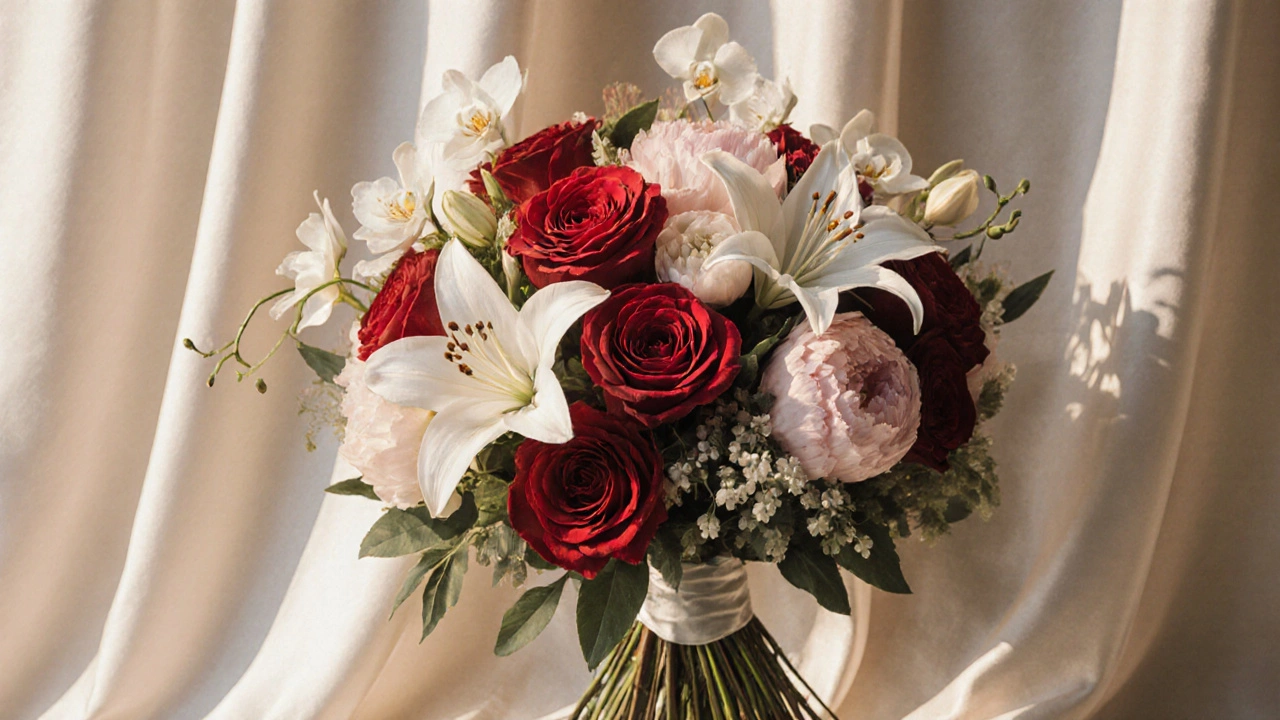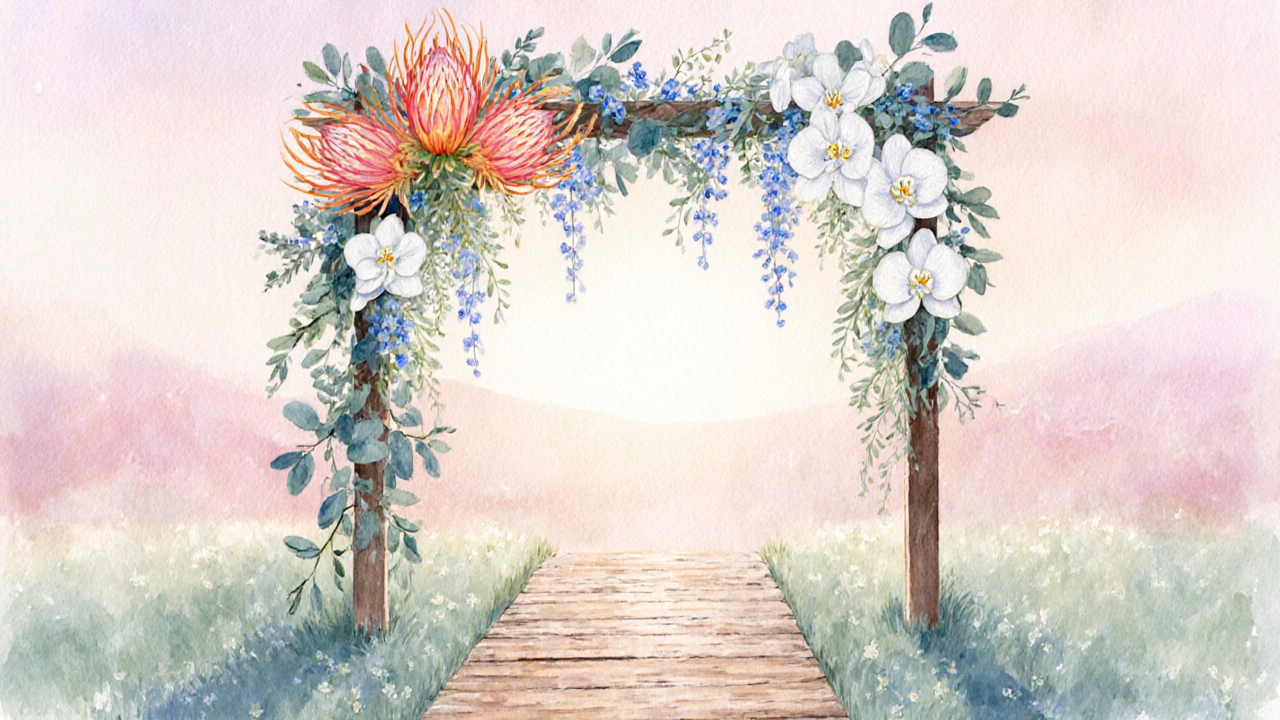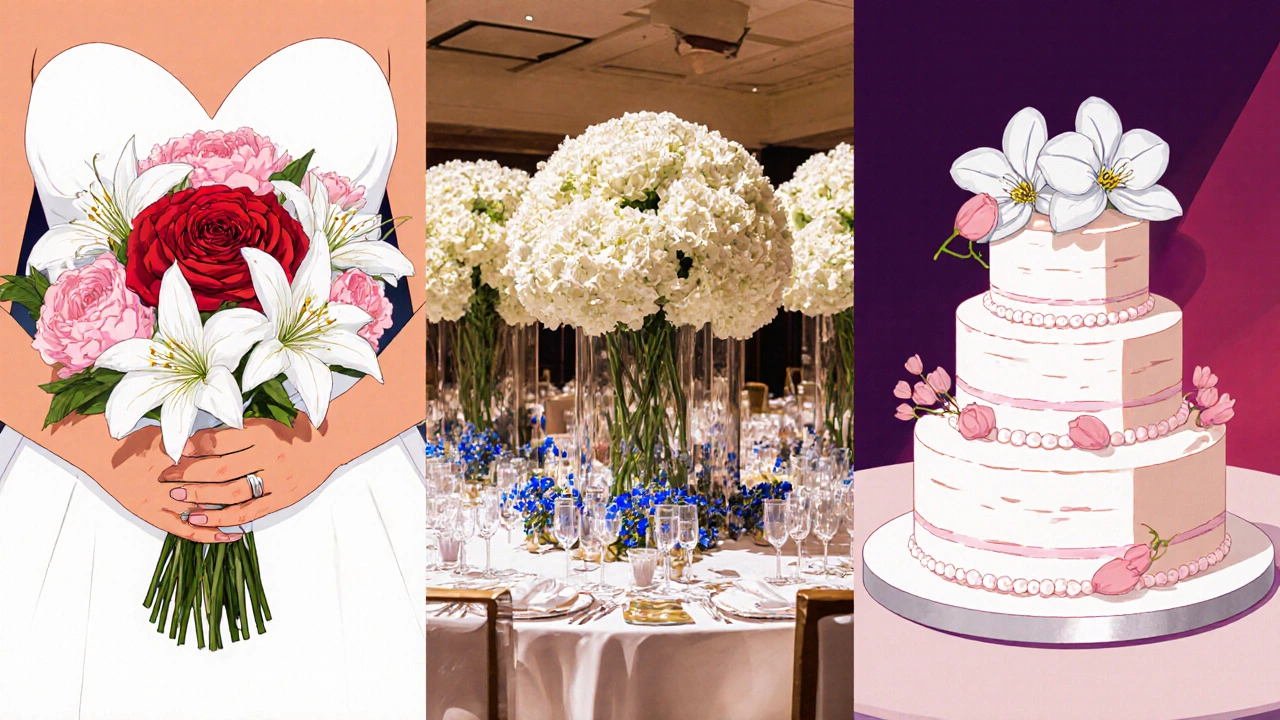Wedding Flower Symbolism: Best Blooms for Your Big Day
 Oct, 8 2025
Oct, 8 2025
Wedding Flower Symbolism Selector
Select flowers below to learn about their symbolic meanings and how they can enhance your wedding theme.
Rose
Love, passion, admiration
Lily
Purity, devotion, new beginnings
Orchid
Exotic love, elegance, strength
Peony
Romance, prosperity, happy marriage
Tulip
Perfect love, renewal
Forget-Me-Not
Remembrance, faithful love
Selected Flower Symbolism
Click on a flower above to see its symbolic meaning and usage suggestions.
Usage Suggestions
- Select a flower to see usage ideas
Cultural Notes
- Select a flower to see cultural interpretations
Key Takeaways
- Roses, lilies, and orchids are the most traditional symbols of love, purity, and luxury.
- Modern couples often add tulips, forget‑me‑not, or native Australian protea for a personal twist.
- Choose flowers that match the emotions you want to convey-romance, faithfulness, or new beginnings.
- Blend symbolic blooms into bouquets, centrepieces, and ceremony arches for a cohesive story.
- Avoid over‑matching colours; let each flower’s meaning shine through its natural hue.
When you hear the word "wedding," what image pops into your head? Most people picture a cascade of fresh blooms, each carefully chosen for its beauty and, often, its hidden meaning. Understanding which flower symbolizes marriage helps you shape the emotional tone of your ceremony without saying a word. Below you’ll find a deep dive into the most popular symbols, modern alternatives, and practical tips for weaving them into every part of your big day.
Wedding flower symbolism is the practice of selecting specific blooms that convey love, commitment, and cultural values during a marriage celebration. By matching the right flower to the story you want to tell, you turn ordinary décor into a heartfelt narrative that guests feel instinctively.
Traditional Symbolic Flowers
Many couples start their search with the classics-flowers that have carried wedding meanings for centuries across Europe, Asia, and the Americas.
Rose is a timeless emblem of love, passion, and romance. Red roses declare deep love, while pink roses whisper admiration and gratitude. White roses are often chosen for purity and new beginnings, making them a popular choice for both bouquets and table arrangements.
In the Victorian language of flowers, a single rose meant “I love you,” whereas a bouquet of ten spoke “I love you forever.” Today, designers mix rose varieties to create layered meanings-for example, pairing red and white roses to balance passion with the fresh start of marriage.
Lily is a symbol of purity, devotion, and the transition to a new life. White lilies dominate many bridal cabinets because they evoke the innocence of a white wedding dress and the spiritual purity of the vows. Calla lilies, with their sleek trumpet shape, add a modern elegance while still communicating fidelity.
A lesser‑known fact: in Greek mythology, lilies grew where the gods placed the souls of the dead, representing eternal life. This connection makes lilies a gentle reminder that love, like the soul, endures beyond the ceremony.
Orchid is a luxurious flower that stands for refined beauty, exotic love, and strength. Its exotic appearance works especially well for upscale venues or destination weddings. White orchids convey pure elegance; pink varieties add a subtle romantic flair.
Because orchids bloom only once a year, they also symbolize rarity and the preciousness of the day itself-perfect for couples who view their wedding as a once‑in‑a‑lifetime event.
Peony is a generous flower representing romance, prosperity, and a happy marriage. In Chinese culture, peonies are called "the king of flowers" and are believed to bring a harmonious, prosperous union. Their lush, layered petals make them ideal for full‑bodied bouquets that feel both romantic and abundant.
When paired with softer blooms like roses or ranunculus, peonies add depth without overwhelming the overall palette.

Modern & Regional Symbols
While traditional flowers never go out of style, modern couples often look for blooms that tell a more personal story-whether that’s a nod to their heritage, a favorite colour, or an interest in sustainable sourcing.
Tulip is a versatile bloom that symbolizes perfect love and renewal. In Dutch folklore, tulips were a sign of unconditional love, making them a popular choice for spring weddings. Their simple, elegant shape works well in both classic and contemporary arrangements.
Their variety of colours-red for true love, purple for royalty, yellow for cheerfulness-gives couples a handy colour‑coding system to match the tone of each ceremony element.
Forget‑me‑not is a tiny blue flower that stands for remembrance and faithful love. Its delicate appearance adds a nostalgic feel, especially in rural or garden‑style venues. Many couples use them as filler in bouquets or as a subtle accent on cake toppers.
Because the flower’s name literally says “do not forget,” it’s a sweet way to promise lifelong memory with your partner.
Hydrangea is a voluminous bloom representing gratitude, abundance, and heartfelt emotions. In Japan, hydrangeas are linked to heartfelt apologies and gratitude, making them a fitting tribute to families who have supported the couple.
Hydrangea’s natural ability to change colour based on soil pH lets you customise its hue to fit any wedding palette-from soft blues to deep magentas.
Protea is Australia’s national flower symbolising change, hope, and courage. Melbourne‑based couples love incorporating protea for a local touch that also conveys resilience-perfect for couples who have overcome challenges together.
Its bold, sculptural head works as a striking centrepiece or as an eye‑catching accent in a cascading bouquet.
How to Choose the Right Symbolic Flower
- Define the emotion you want to highlight. Love? Fidelity? New beginnings? Match each feeling to a flower’s traditional meaning.
- Consider your venue and season. Spring weddings naturally lend themselves to tulips and peonies, while winter settings pair beautifully with white roses and evergreen foliage.
- Think about colour harmony. Some flowers, like hydrangea, can be colour‑adjusted, while others have fixed palettes that may dictate the overall scheme.
- Factor in availability and budget. Exotic orchids may cost more and need specialist handling, whereas locally sourced protea or native daisies can be cost‑effective and eco‑friendly.
- Test with a mini‑mockup. Ask your florist for a sample arrangement to see how meanings and colours interact in real life.
Incorporating Symbolic Flowers into Your Wedding
Once you’ve selected your symbolic blooms, spread their meaning throughout the event for a cohesive story.
- Bridal bouquet. Make the central meaning stand out-e.g., a red‑rose core for passionate love surrounded by white lilies for purity.
- Ceremony arch. Drape orange‑blossomed protea and white orchids along the arch to blend resilience with elegance.
- Reception centrepieces. Use tall hydrangea stems with interspersed forget‑me‑not for a layered narrative of gratitude and remembrance.
- Cake décor. Top your wedding cake with a single rose or a small cluster of tulips, signalling the centerpiece emotion of the day.
- Bridal party arrangements. Give each bridesmaid a different bloom that reflects her personal connection to the couple-e.g., a pink peony for “joyful support” and a white lily for “faithful friendship.”
Every placement is an opportunity to reinforce the underlying message without saying a word.

Common Mistakes & Pro Tips
- Over‑matching colours. Using only one colour can mute the symbolic impact. Mix complementary shades to let each flower’s meaning shine.
- Ignoring cultural context. Some symbols differ by region-white lilies mean purity in Western weddings but can symbolize death in parts of Asia. Choose wisely if you have multicultural guests.
- Choosing based solely on aesthetics. A pretty flower that carries an unintended meaning could send a mixed message. Verify meanings before finalising.
- Forgetting seasonality. Out‑of‑season blooms can inflate costs and reduce freshness. Work with a local florist to find seasonal equivalents that share the same symbolism.
- Neglecting sustainability. Opt for locally grown or fair‑trade flowers to keep your wedding eco‑friendly and support responsible growers.
Comparison of Popular Wedding Flowers
| Flower | Classic Meaning | Common Wedding Role | Popular Colour Palette |
|---|---|---|---|
| Rose | Love, passion, admiration | Bouquet centre, cake topper | Red, pink, white, ivory |
| Lily | Purity, devotion, new beginnings | Arch garlands, centrepiece filler | White, cream, soft pastel |
| Orchid | Exotic love, elegance, strength | Luxury bouquets, table runners | White, pink, deep purple |
| Peony | Romance, prosperity, happy marriage | Full‑bodied bouquets, bridal crowns | Blush, coral, soft pink |
| Tulip | Perfect love, renewal | Spring‑season blooms, altar decor | Red, purple, yellow, white |
| Forget‑me‑not | Remembrance, faithful love | Filler in bouquets, cake accents | Blue, white |
| Hydrangea | Gratitude, abundance | Large centrepiece clusters | Blue, pink, purple, green (pH‑dependent) |
| Protea | Change, hope, courage | Statement pieces, native‑theme décor | Orange, pink, red, ivory |
Frequently Asked Questions
Which flower is the most romantic for a wedding bouquet?
Red roses are universally recognized as the epitome of passion and romance, making them the top choice for couples who want a classic, love‑filled bouquet.
Can I mix symbolic flowers with non‑symbolic filler without losing meaning?
Absolutely. Use filler like baby's breath or eucalyptus to support the main symbolic blooms. The focal flowers still convey their meanings while the filler adds texture and volume.
What are good native Australian options for a symbolic wedding?
Protea and native banksia are popular choices. Protea stands for courage and change, while banksia symbolizes resilience-perfect for couples who love their Aussie roots.
Do flower meanings change across cultures?
Yes. For example, white lilies represent purity in Western weddings but can denote mourning in some Asian traditions. Always double‑check cultural interpretations if your guest list is diverse.
How can I keep my wedding flowers sustainable?
Choose locally grown, seasonal blossoms, work with farms that practice fair‑trade, and consider re‑using the arrangements as home décor after the event.